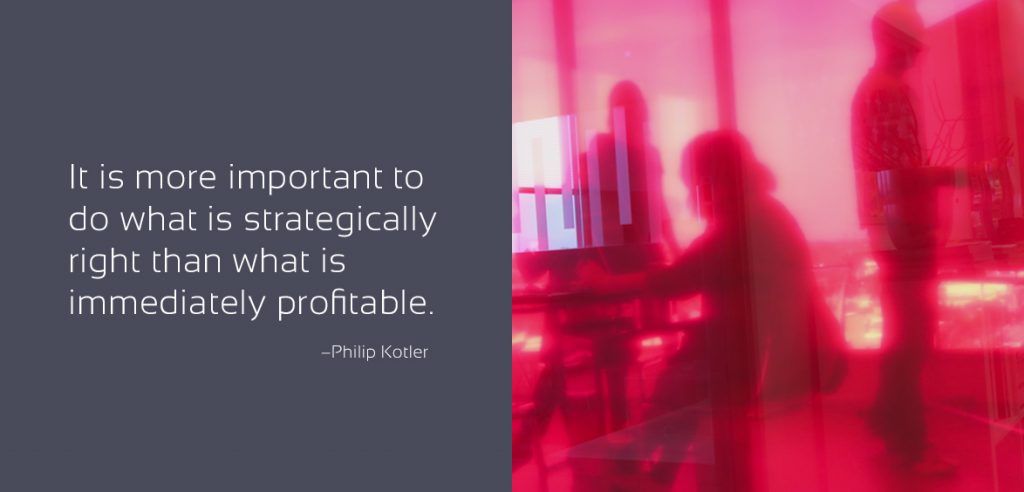Defining Your Optimal Brand Strategy – Part 1
 Competing in today’s hyper-competitive furniture market is challenging enough let alone having to make your way through all the chaos. As discussed in our last blog, there are plenty of daunting challenges faced by today’s legacy furniture brands: the generational shift, lack of resources, multiple targets and adapting to technology.
Competing in today’s hyper-competitive furniture market is challenging enough let alone having to make your way through all the chaos. As discussed in our last blog, there are plenty of daunting challenges faced by today’s legacy furniture brands: the generational shift, lack of resources, multiple targets and adapting to technology.
Over the next two blog posts, we will guide you through the key points of developing an optimal brand strategy that starts with defining your brand goals.
This blog will cover the initial steps needed to provide the much needed clarity for your team to begin creating a blue print for the future of your brand–in essence, an optimal brand strategy.
Defining Your Brand Goals
A successful vision starts with asking yourself and your team what your brand goals are.
We know you want to sell more but really think about some of the underlying goals that will increase your sales.
Here are some questions to help guide your conversation:
- Are you trying to shift perception?
- Are you trying to attract an entirely new audience?
- Do you have a new product line?
- Are you expanding operations?
- What are the brand key differentiators?
Whatever it may be, your brand strategy should answer these questions with clear and well-defined goals.
“Leverage brand name, equity, expertise and reputation to expedite client diversification and overall company / market growth”
You will want to have at least 5 -7 well-defined goals that will guide the creative development.
Understanding Your Target Audience
Once your goals have been defined and agreed upon by the key stakeholders, the next step will be to define who your brand is talking to.
Whether your company is B2B or B2C you should understand who your end-user is and what their needs are. As a B2B company it is important to consider your buyers / retail partners, but when you know what your end-consumer is looking for you will be able to build awareness and loyalty–thus driving demand. This knowledge will positively impact all areas of your business–not only marketing and sales but also with production and design.
Some basic questions to help determine your audience are:
- Where are they located?
- How old are they?
- What are their buying habits?
Now that you’ve defined your goals, and you understand who you are talking to, who is buying your products, let’s define what your brand stands for.
Developing Your Core Values
Core values can be as simple as “Exceeding our customers’ expectations” (Dwell).
Or as in-depth as “make a difference’ by positively impacting the environment, society and communities in which we operate whenever possible,” (Surya). In the end, it is up to what you and your brand believes in and what drives success day-to-day.
Core values do not always have to come from the top down, they can also come from the bottom up – reflecting your company culture as a whole.
We recommend coming up with a minimum of 5-8 core values as these will guide much of your creative messaging and content.
Living Your Passions
We are all passionate about something and so are brands, as they are made by people for people.
When developing a passions list it is important to think beyond personal passions and include those of your team and your target audience. Passions should connect with everyone beyond a superficial level – more on an personal and emotional level; although it is recommended to include some that are tied to your business and the furniture industry as a whole.
Like the core values, we recommend coming up with a minimum of 5-8 passions, as these will guide much of your messaging and creative content.
Now that you have begun to build a solid foundation for your brand strategy, the next step will be to define the brand’s overall position, key messaging, and tone and voice.
We will be covering these points in detail in part 2 of building an optimal brand strategy.



Pingback: 3 Ways to Empower your Success with Retailers through your Online Presence – Furniture Branding
Pingback: 3 Ways to Empower your Success with Retailers through your Online Presence - Furniture Branding
Pingback: Defining Your Optimal Brand Strategy – Part 2 - Furniture Branding